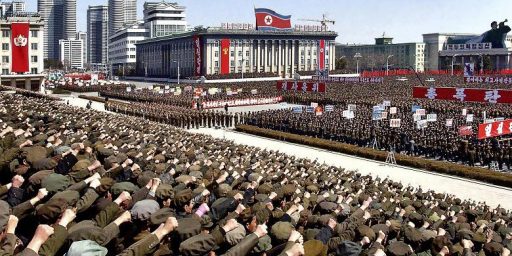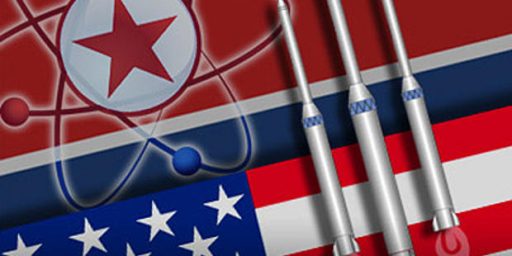North Korean Video May Signify Emerging Anti-Government Movement
The Los Angeles Times describes the significance of a video that shows rebellious acts against Kim Jong Il:
Secret N. Korean Footage Suggests Nascent Dissent (LAT)
The 33-minute tape has created a sensation in Japan and South Korea, where it has aired repeatedly. South Korean human rights advocates say it is the first evidence of a nascent dissident movement inside North Korea.
Besides the banner hung on the bridge, the video shows an anti-government banner in a factory restroom and has one particularly eye-catching scene in which the camera pans over an official photograph of Kim Jong Il defaced with graffiti as a man denounces him off-camera.
The video is one of a series of samizdat videos that provide a rare glimpse of life in what may be the most secretive country in the world. Since the beginning of this year, videos have emerged from inside North Korea of a public execution, children begging at a train station and humanitarian aid from the United Nations being sold at a market.
Among North Korea watchers, there is some debate about whether the filmmakers were motivated mainly by their opposition to the government or by greed. Many of the videos have been sold to Japanese television stations, which have paid as much as $200,000 for choice footage, according to some accounts.
That people are able to make such videos challenges many of the assumptions about Kim’s grip on power. The videos do not necessarily mean the government is on the verge of collapse — the majority opinion among analysts is that it is not — but their existence shows that social control is fraying at the edges.
“Nobody would have dared to do such a thing three or four years ago,” said Hitoshi Takase, president of Japan Independent News Net, a Tokyo-based company that distributed footage in March of an apparent public execution in North Korea.
A six-minute excerpt is available at Daily NK. It’s sparked debate among knowledgable observers:
Much of Park’s account can be confirmed. A Japanese broadcaster, Asahi Television, which also interviewed Park, did a sound analysis and concluded that he was the man whose voice is heard in the footage, program director Hiromichi Shizume said.
Numerous defectors who have seen the footage say that several scenes, particularly the one at the bridge, were clearly shot in Hoeryong. But they, along with North Korea analysts, expressed doubts about whether the Freedom Youth League was a genuine dissident movement or just a few guys trying to make a quick buck.
“I don’t believe there are conditions in North Korea for any kind of real opposition movement. These people are out for money,” said journalist Chu Sung Ha, a defector in Seoul who covers North Korea.
North Korea permits only state-owned publications or broadcasting; even the slightest criticism of Kim Jong Il can result in execution or deportation to a prison camp. Under its law, three generations of a family can be punished for the crimes of one member.
Regardless of the motives, there is little doubt that a growing number of North Koreans have found new purpose as amateur filmmakers trying to document their country for foreign TV. In many cases, the video cameras have been supplied by activists and defectors living in South Korea.
It’s hardly surprising that some involved parties seek profits. But such motivations shouldn’t distract us from the real issue at hand: whether a true dissident force is growing. If, after setting aside all the greed, we learn that an actual movement exists, then we should figure out how it is positioning itself for change. It may be too nascent at this stage. It may have very little impact on the multilateral negotiations. But, if it expands, then surely we should be encouraged.






To risk those penalties, there has to be more than just money as a motivator.
In a “Worker’s Paradise” isn’t greed in and of itself dissent? I think the defector-journalist quoted is discounting this as an opposition because it doesn’t look like the one he envisioned himself leading before he decided the best he could do is get out.